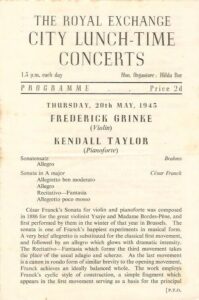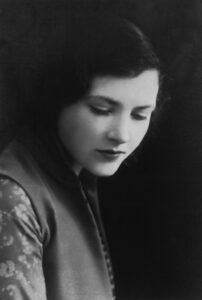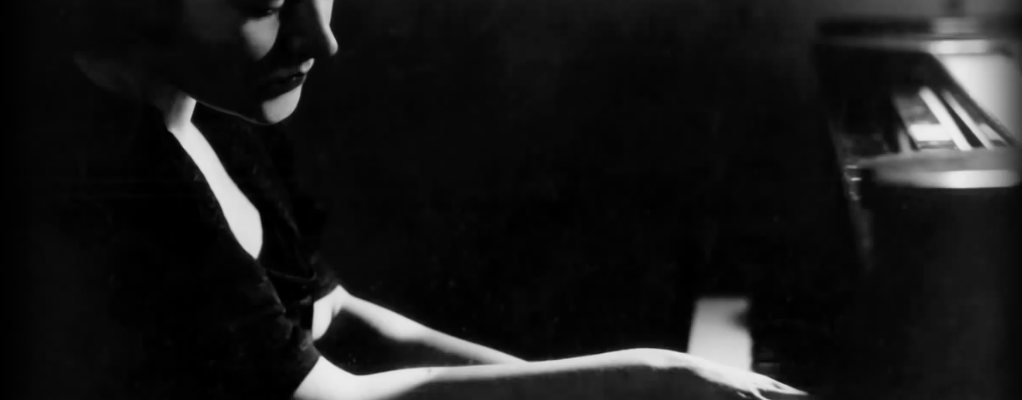
Yet another pianist I’d never heard of showed up in a YouTube upload recently and I was stunned by the playing. The artist was one Hilda Bor, a pupil of Tobias Matthay and then Vivian Langrish when Matthay retired from the Royal Academy of Music. Bor later taught as a member of Matthay’s staff and arranged wartime concerts at the Royal Exchange at the same time that fellow Matthay pupil Myra Hess arranged her more famous events at the National Gallery. Among Bor’s pupils were Prince Charles and Princess Anne (the job had originally been offered to Hess but she preferred not to teach children).

The British pianist produced only two 78s for the Columbia label in the late 1930s, totalling a mere 12 minutes. The first was a July 16th 1937 disc featuring a Chopin Waltz and Prelude on one side, and two dazzling ‘bee’ works on the B-side (no pun intended): Mendelssohn’s Bee’s Wedding (aka Spinning Song) and Rachmaninoff’s arrangement of Rimsky-Korsakov’s Flight of the Bumble-bee. The second disc with three Grieg Lyric Pieces was set down on January 24, 1939. Both are presented here courtesy of Jonathan Dobson, who transferred and made them available for this upload and to whom we offer our sincerest thanks.
Bor’s playing throughout these selections features remarkable clarity of articulation and rhythmic precision in rapid passages while sustaining mindful phrasing, poised balance not only between hands but within the voicing of chords, and gorgeous ringing tone throughout. Her left-hand voicing is superb, as evidenced in the Chopin Prelude, and she maintains steadiness of rhythm and deftness of articulation in the first Grieg number even at the substantial speed that she chose (a colleague of mine stated that it was so brisk that it might be considered a shotgun wedding). In addition to her evidently polished technique, she also demonstrates fine musicianship in these rare performances.
Hilda Bor: The Columbia 78s
Chopin: Waltz in F Minor Op.70 No.2
Chopin: Prelude Op.28 No.3
Mendelssohn: Bee’s Wedding (aka Spinning Song)
Rimsky-Korsakov arr. Rachmaninoff: Flight of the bumble-bee
(recorded July 16, 1937)
Grieg – Three Lyric Pieces:
Wedding Day at Troldhaugen Op.65 No.6
Papillon Op.43 No.1
Oisillon Op.43 No.4
(recorded January 24, 1939)
On YouTube there is also an excerpt from a BBC transmission disc in which Bor plays Bartók’s Román kolindadallamok (Romanian Christmas Carols). Despite the prominent crackle from the record, we can appreciate her beauty of tone (not a given in readings of Bartók), burnished voicing, clarity of texture, and rhythmic vitality:
Bor lived until 1993 and quite why she faded from memory is a mystery (likely the lack of commercial records was a contributing factor) – a fate that has befallen too many great artists.
There’s a mini documentary that’s been produced by her great-nephew Fred Burns that also includes an excerpt of a BBC broadcast (a Chopin Waltz not on her 78rpm disc above) – here’s that link:
One hopes that more of this great artist will be found and made available – she was clearly a remarkable musician!

Comments: 3
Glad to hear the Grieg selections. Wedding Day at Troldhaugen is on the fast side but good, beautiful tone in Butterfly. The Little Bird……this is the first time I’ve heard this, other than Grieg’s own piano roll, recorded off the radio long ago. I wonder if Bor also taught Princess Diana………she mentions playing something by Rachmaninov in a particularly infamous interview.
Thanks for posting this, Mark. I wrote about Hilda Bor rather extensively in my Matthay biography, England’s Piano Sage, and those sections were assisted immeasurably by her brother, Edwin, who was even kind enough to give me the letter that Myra wrote to the palace recommending Hilda as the teacher of the Prince and Princess.
I had never heard these wonderful recordings, so I’m thrilled to have the opportunity. As is explained in the book, just a few years earlier, Hilda suffered two unspeakable tragedies. First, her fiance, Eric Brough, a superb pianist and one of Langrish’s most promising students, was killed when his seaplane crashed just off the coast of Trinidad while he was judging for ABRSM auditions. That was in April of 1936. Brough shared a position at the Congregational Church in Lewisham with (Dennis) Yelland Richards, and over the next year, Hilda grew increasingly close to him. Then in March of 1938, Richards died in a rock climbing accident in Wales, and in April Hilda participated in a memorial concert for both men. These wonderful recordings were made only about 8 months later. Hilda never married, and some suggested that her grief was so overpowering that she never fully recovered.
Thanks so much again.
When my teacher, Denise Lassimonne, entered Matthay’s household at the age of 16, he put her in charge of teaching the youngest children at his piano school, and she was evidently remarkably successful. But 10 years later, that mantle was conferred on Hilda, who was then 19 and quickly became one of the most noted teachers of children in Britain. She was everything Matthay always believed that the finest primary teachers should be, i.e. a superb artist as well as an outstanding teacher. Denise used to talk about her a lot. She repeatedly called her “a genius,” and I’m only sorry I never got the opportunity to meet her.
Thank you very much for this comment, Stephen. I only recently got your book (just around the time I got these recordings) and have just had a very brief opportunity to peruse its richness, but I’ll add a few relevant details about Bor… thank you for highlighting these key points in your comment. How incredible that these wonderful recordings should have been so close to those tragedies. She clearly was a superb musician – I’m glad to hear that Lassimonne thought so highly about her.